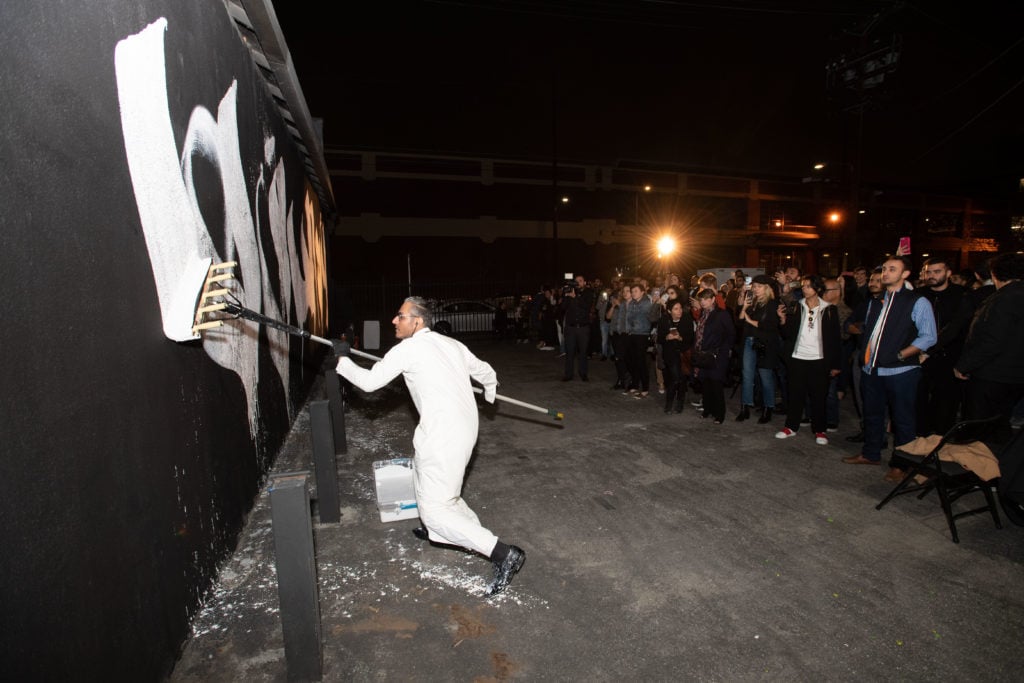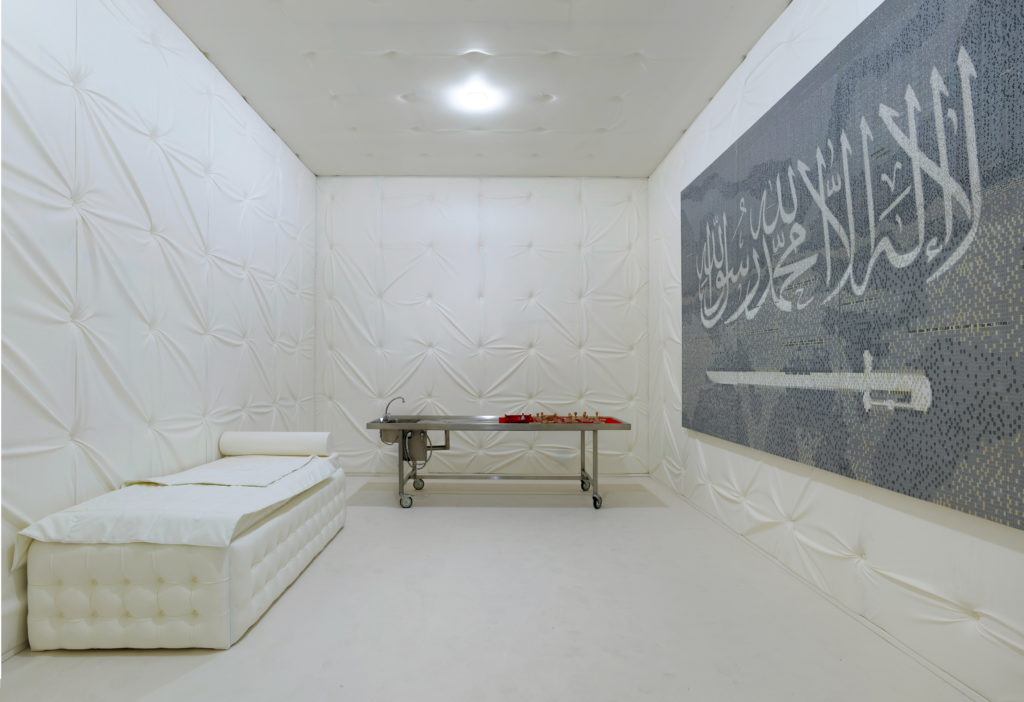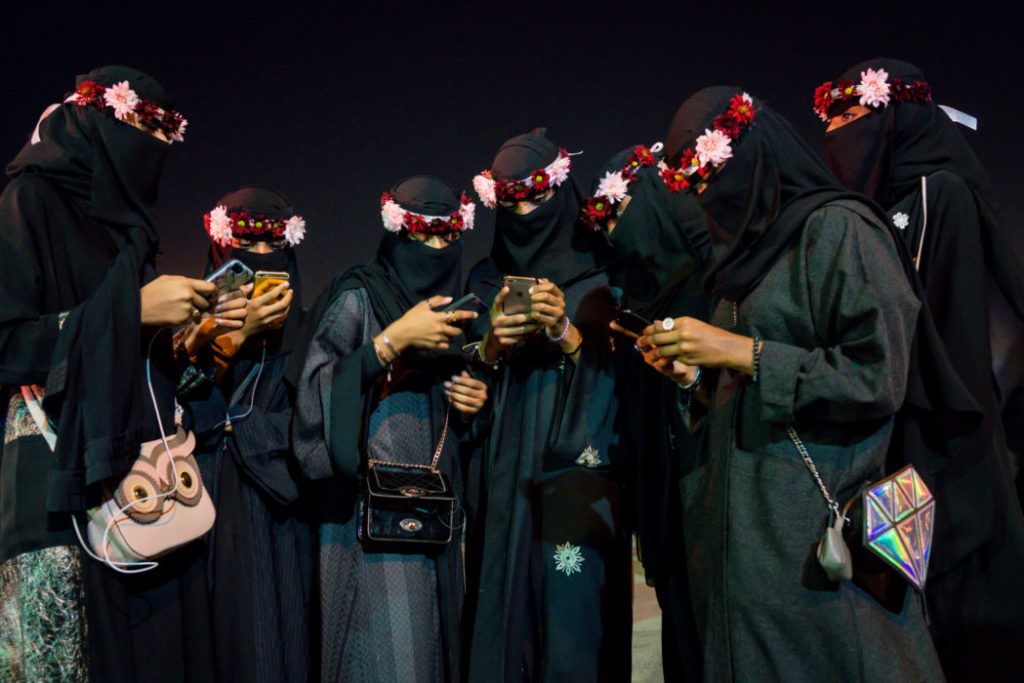Art World
‘We Have Our Own Individual Voices’: Saudi Artists Debate Their Place in the Kingdom as the West Becomes Wary of Its Commitment to Progress
The kingdom is gambling on culture as a new economic driver.

The kingdom is gambling on culture as a new economic driver.

Rebecca Anne Proctor

Against the endless, arid landscape of the harsh Jeddah desert, a man in a white thobe, the traditional Saudi male dress, approaches a camera. Walking swiftly and with utmost determination, he carries a paintbrush dripping with crude oil.
An eerily violent mood fills the air as he takes his paintbrush and begins to paint in wide strokes along a giant glass surface. A few calligraphic marks emerge until the man, Saudi artist Nugamshi, smashes the glass and his painting.
The resulting video, Sarab (2016), was included in “Naphtha,” a summer exhibition curated by artist Moath Alofi at the Khuzam Palace in Jeddah and organized by the Saudi ministry of culture. It stands as a provocative representation of the changes taking place in the country, and a potent symbol of its attempted break with the past as it enters new terrain under 33-year-old crown prince Mohammed bin Salman, known as MbS, who has promised modernizing reforms.
The exhibition, which presented artworks that explored the social and economic consequences of the kingdom’s oil economy, is also reflective of Saudi Arabia’s grand plans to wean itself off of the energy market by developing a new “creative economy.”
But inevitably, the work also recalls the country’s shattered relations with the West since the murder, last October, of dissident journalist Jamal Khashoggi at the Saudi embassy in Istanbul. Although MbS has denied any wrongdoing, authorities around the world, including the CIA, have squarely blamed him for ordering the assassination.
Now, as the country looks to reconcile its various challenges and opportunities, artists are debating their place in the unfolding conversation.
![Ahmed Mater,<i> From the Real to the Symbolic City,</i> (2011–13) [detail]. Courtesy of the Smithsonian Freer Sackler.](https://news.artnet.com/app/news-upload/2019/09/banner-S2014.5-1024x439.jpg)
Ahmed Mater, From the Real to the Symbolic City, (2011–13) [detail]. Courtesy of the Smithsonian Freer Sackler.
Early in his reign, MbS was praised around the world for reforms that loosened restrictions in the ultra-conservative Gulf country. The ban on women drivers was lifted and the economy was slowly becoming diversified. But since Khashoggi’s death, a series of boycotts and protests—including the cancellation last October by New York’s Columbia University of a talk by visiting Saudi artist Ahmed Mater—have left the Saudi art scene in a difficult spot.
One anonymous American curator working for a US organization in the Middle East said that while she was interested in the country’s art scene, she felt looking into it would be frowned upon by her institution. “It’s not the right time,” she tells artnet News.
But those inside the country urge interested parties to distinguish between Saudi artists and the Saudi state.
“It is important now to separate the people and the artists from the government and the powers that be,” says Stephen Stapleton, the former international director, with Mater, of the Misk Art Institute, a Saudi state-run cultural initiative. “We are living a very emotional moment. We must never forget what happened to Jamal and what he stood for, as we can’t forget America’s decision to go to war with Iraq.”
Stapleton, who is also the founder of Edge of Arabia, CULTURUNNERS, and the Crossway Foundation, says a boycott of the scene by the West won’t bring about any positive change. “[In Saudi Arabia] you have a very important young art scene that has grown out of a conversation with the international community,” he says. “[We] might be seen as abandoning it if we don’t keep that dialogue open.”
One example of that nascent freedom is a work directly inspired by the gruesome murder of Khassogi: Saudi artist Abdulnasser Gharem’s The Safe, which was shown in June at Art Basel. In the work, Gharem created a memorial for the journalist as a way to stress that dissident voices still exist in the country.
“I wanted to show ‘the other,’ or the West, that this work could come out of Saudi Arabia,” he told artnet News. “We have our own individual voices.”

Installation view of Abdulnasser Gharem’s The Safe (2019), courtesy of Art Basel.
While the outside world continues to grapple with how to deal with Saudi Arabia, those inside the country say that reforms have inaugurated real change.
“Just under two years ago, music was not allowed to be played at restaurants and families would have curtains to hide from neighboring families,” says Saudi-American photographer Tasneen AlSultan, who is a member of the Rawiya Women’s Middle Eastern Photography Collective, and who has documented gender and social issues in the kingdom for the New York Times and National Geographic.
“Women weren’t allowed to travel or renew their passports without the approval of their legal male guardians,” she explains. “Now we find live musical bands flown in from across the world to entertain families at restaurants, malls, and parks.”
“My images have changed [as a result],” AlSultan continues. “I was able to photograph the first music concert in Jeddah with [Algerian singer] Cheb Khaled and [US rapper] Nelly. The first woman officially to drive was last year. Our struggles will be vastly different from those of my daughter’s generation.”
Cinemas, along with mixed-sex music festivities and clubs, are now open, a result of MbS’s plan to open new economies beyond the oil industry. The country also plans to increase the number of festivals and events from 300 to 500. And according to a recent report by the state tourism center, spending on tourism could rocket up to 174 billion Saudi rials ($46 million) by 2020 from 104 billion (USD27m) Saudi rials in 2015.
Meanwhile, the Misk Art Institute established a permanent national pavilion for Saudi Arabia at the Venice Biennale this year, and the organization’s plans include the opening of a major museum in Riyadh in 2020 and the start of the Riyadh Biennial.
“Forty years ago we were told certain things were haram [bad] and now we are told they are not haram,” says Abdullah Hadi Asri, who runs the Shmokh Resort in Abha in Southeastern Saudi Arabia. “I feel like I’ve lost 40 years of my life but it is different for the younger generation.”
“The goal is to massively support the cultural sector, helping make art and culture part of people’s everyday lives, enriching life for Saudis, boosting the economy, and creating opportunities for cultural exchange,” said Abdulkarim Alhumaid, a spokesperson for the ministry of culture.

Tasneem Alsultan, A group of relatives busy on their social media phone applications, at Al-Jenadriyah, a cultural festival in Riyadh. (2018). © Tasneem Alsultan.
Even during the country’s most repressive years, and long before the existence of state-sponsored projects, Saudi Arabia had an art scene run by self-taught artists and wealthy private patrons.
The cultural powerhouse Art Jameel, founded in 2003 by the wealthy Jameel family, is responsible for numerous initiatives, including the Jameel Art Center in Dubai and the Hayy Creative Hub, due to open in Jeddah in spring 2020.
The Al Mansouria Foundation has an even longer history, having been founded in 1990 by Princess Jawaher Bint Majed Bin Abdulaziz al-Saud. The Pharan Studio, an artist-led space, and the Hafez Gallery in Jeddah are also important reference points. Edge of Arabia was founded in 2003 by Stapleton with artists Gharem and Mater.
Yet while many have compared Saudi Arabia’s sprint into the future to similar changes that took place in Qatar and the United Arab Emirates, where state actors wielded culture as a tool of soft power, some think the parallels are misleading.
“When things move fast and you are in the middle of them, you cannot comprehend the speed,” says Mohammed Hafiz, an art collector and co-founder of Athr Gallery, a contemporary art space established in Jeddah in 2009.
“What is happening in Saudi Arabia now did not happen in Doha, Dubai, or even Abu Dhabi. We have a population north of 30 million people.” Hafiz argues that similar developments in other Gulf nations were primarily geared to outside audiences, but that Saudi developments are driven by and directed at the country’s own population.
Yet while winds of change can be felt, there is doubt and fear as to how long they will last.
“The ‘grass root’ has shifted from under us,” said Riyadh-based artist Muhannad Shono. “The art scene is attempting to replant its feet, but we can’t just get complacent or take these new changes for granted.”
Others are more outright skeptical about the narrative. “It’s all about nation and image-branding—it’s not genuine,” said one British journalist who spoke on the condition of anonymity.
Finally, some in the country seem to think the whole discussion misses the key point for artists. “Yes, there are women driving and there are musicians playing, but as for the artists and their practices, the practice remains the same,” says Hafiz, the collector and gallery owner. “There is now a larger space for artistic expression and a large number of new opportunities. [But] I believe that the so-called restrictions have forced artists to think outside the box. When you are an artist here, you find your voice in between these restrictions.”